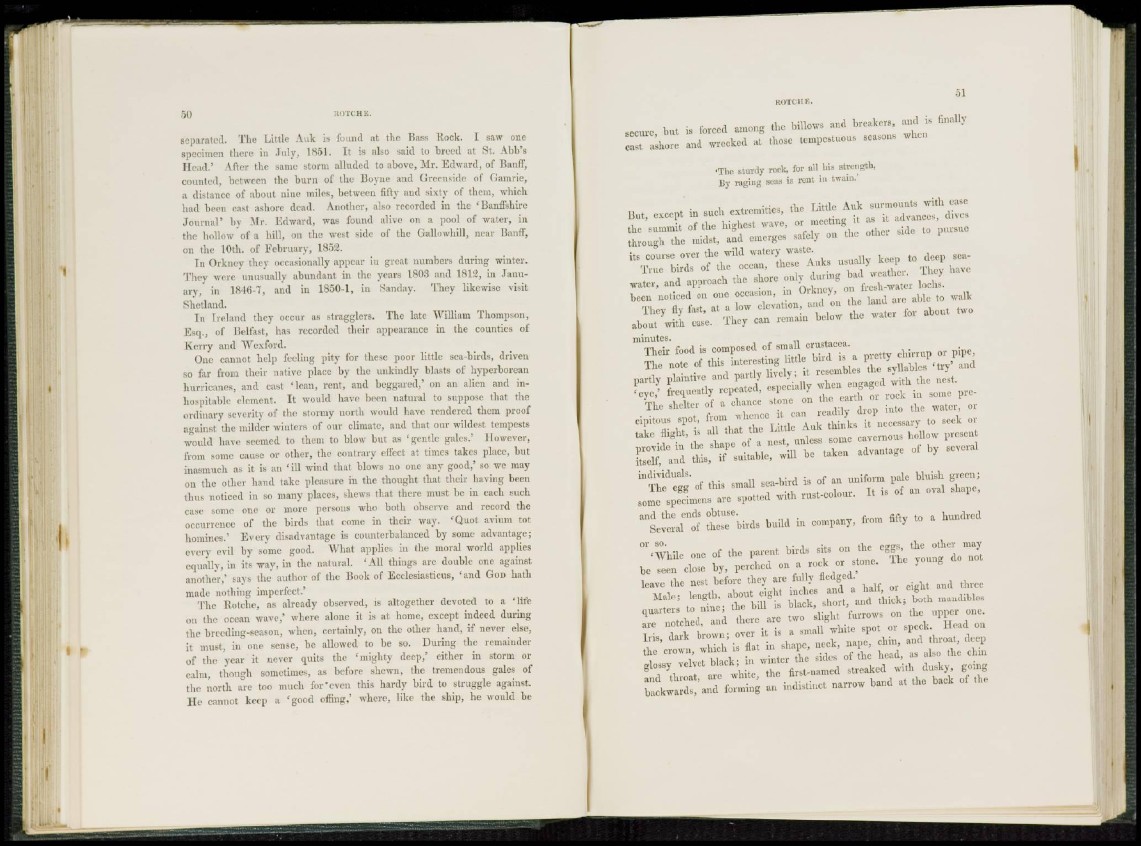
50 aoTcaa.
separated. The Little Auk. is found at the Bass Rock. I saw one
specimen there in -July, 185). It is also said to breed at St. Abb's
Head.' After the same storm alluded to above, Mr. Edward, of Banff,
counted, between the burn of the Boyne and Crecnside of Camrie,
a distance of about nine miles, between fifty and sixty of fhcin, which
had been cast ashore dead. Another, also recorded in the 'Banffshire
J o u r n a l ' by .Mr. Edward, was found alive on a pool of water, in
the hollow of a hill, on the west side of the Gallowhill, near Banff,
on the 10th. of February, 1852.
I n Orkney they occasionally appear iu great numbers during winter.
They were unusually abundant in the years 1803 and 1812, in January,
in 1846-7, and in 1850-1, in Sanday. Thev likewise visit
Shetland.
I n Ireland they occur as stragglers. The late William Thompson,
Esq., id" Belfast, has recorded their appearance in the counties of
Kerry and Wexford.
One cannot help feeling pity for these poor little sea-birds, driven
so far from their native place by the unkindly blasts of hyperborean
hurricanes, and cast 'lean, rent, and beggared,' on an alien and inhospitable
clement. It would have been natural to suppose that the
ordinary severity of the stormy north would have rendered them proof
against the milder winters of our climate, and that our wildest tempests
would haver seemed to them to blow but as 'gentle gales.' However,
from some cause or other, the contrary effect at times takes place, but
inasmuch as it is an ' i l l wind that blows no one any good,' so wc may
on the other hand take pleasure in the thought that their having been
thus noticed in so many places, shews that there must be in each such
c a v some one or more persons who both observe and record the
occurrence of the birds that come in their way. 'Quot avium tot
homines.' Every disadvantage is counterbalanced by some advantage;
every evil by some good. What applies in (he moral world applies
equally, in ifs way, in the natural. 'All things are double one against
another,' says the author of the Book of Ecclesiasticus, ' a n d GOD hath
made nothing imperfect.'
The Rotche, as already observed, is altogether devoted to a 'life
on the ocean wave,' where alone it is at home, except indeed during
the breeding-season, when, certainly, on the other hand, if never else,
it must, in otic sense, be allowed to be so. During the remainder
of the year it never quit! the 'mighty deep,' cither in storm or
calm, though sometimes, as before shewn, the tremendous gales of
the north are too much for'even this hardy bird to struggle against.
He cannot keep a 'good offing.' where, like the ship, he would be
RO'ICHl'.
secure, but is forced among the billows and breakers, and is finally
cast ashore and wrecked at those tempestuous seasons when
'The sturdy rock, for all his strength,
By ruging seaa is rent in twain.'
But, except in such extremities, the Little Auk surmounts with ease
the summit of the highest wave, or meeting it as it advances, dives
through the midst, and emerges safely on the other side to pursue
its course over the wild watery waste.
True birds of the ocean, these Auks usually keep to deep seawater,
and approach the shore only during bad weather. They have
been noticed on one occasion, in Orkney, on fresh-water lochs.
They fly fast, at a low elevation, and on the land are able to walk
about with ease. They can remain below the water for about two
minutes.
ITieir food is composed of small Crustacea.
The note of this interesting little bird is a pretty chirrup or pipe,
partly plaintive and partly lively; it resembles the syllables ' t r y ' and
' e y e , ' frequently repeated, especially when engaged with the nest.
The shelter of a chance stone on the earth or rock in some precipitous
spot, from whence it can readily drop into the water, or
take flight, is all that the l i t t l e Auk thinks it necessary to seek or
provide in the shape of a nest, unless some cavernous hollow present
itself, and this, if suitable, will be taken advantage of by several
individuals.
The egg of this small sea-bird is of an uniform pale bluish green;
some specimens are spotted with rust-colour. It is of an oval shape,
and the ends obtuse.
Several of these birds build in company, from fifty to a hundred
or so.
' While one of the parent, birds sits on the eggs, the other may
be seen close by, perched on a rock or stone. The young do not
leave the nest before they are fully fledged.'
Male; length, about eight inches and a half, or eight and three
quarters to nine; the bill is black, short, and thick; both mandibles
are notched, and there are two slight furrows on the upper one.
I r i s , dark brown; over it is a small white spot or speck. Head on
the crown, which is flat in shape, neck, nape, chin, and throat, deep
glossy velvet black; in winter the sides of the head, as also the chin
and throat, arc white, the first-named streaked with dusky, going
backwards, and forming an indistinct narrow band at the back of the